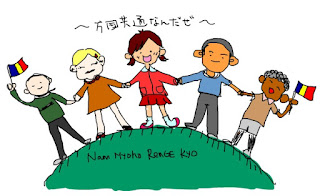みなさ~ん、こんにちは!
さて、今回はちょっと視点をかえまして
「海外の学会員さん」の質問コーナーを一緒にみていきましょう。
〈ご存知ない方...※創価学会のメンバーは日本だけではなくて、世界192ヶ国、地域におります〉
学会員さんが日本人だったら何となく想像できますが、人種や言葉が違う、当然文化も違うメンバーさんは、活動する上で一体何を疑問に思い、何を質問しているのでしょうか。
日本人では思いつかない「海外ならでは」の疑問もあるでしょう。
ということで、
海外のSGIメンバーは、「一体何に疑問を持ち、質問をしているのか」ということをテーマに見ていきたいと思います。
参考に引用するのは、
アメリカSGIのメンバーが読む雑誌「Living Buddhism」や「World Tribune」などのコラムからです。
答え方も日本とは違った視点から回答していたり、お国柄が垣間見れてちょっと面白いですよ。
まあ、お茶でも飲みながら、どんな質問に、どう答えているのかを一緒に見ていきましょう。
今回はその第一回目です。
さて、どんな質問なのでしょうか。
みなさ~ん、こんにちは!
さて、今回はちょっと視点をかえまして
「海外の学会員さん」の質問コーナーを一緒にみていきましょう。
〈ご存知ない方...※創価学会のメンバーは日本だけではなくて、世界192ヶ国、地域におります〉
学会員さんが日本人だったら何となく想像できますが、人種や言葉が違う、当然文化も違うメンバーさんは、活動する上で一体何を疑問に思い、何を質問しているのでしょうか。
日本人では思いつかない「海外ならでは」の疑問もあるでしょう。
ということで、
海外のSGIメンバーは、「一体何に疑問を持ち、質問をしているのか」ということをテーマに見ていきたいと思います。
参考に引用するのは、
アメリカSGIのメンバーが読む雑誌「Living Buddhism」や「World Tribune」などのコラムからです。
答え方も日本とは違った視点から回答していたり、お国柄が垣間見れてちょっと面白いですよ。
まあ、お茶でも飲みながら、どんな質問に、どう答えているのかを一緒に見ていきましょう。
今回はその第一回目です。
さて、どんな質問なのでしょうか。
質問:南無妙法蓮華経を他の言語で唱えないのはなぜですか?
Q: Why don’t we chant Nam-myoho-renge-kyo in any other language?
回答)
南無妙法蓮華経は「ある特定の言語から生まれた言葉」というだけではありません。
Nam-myoho-renge-kyo is more than just a phrase deriving from a particular language.
南無妙法蓮華経は「ある特定の言語から生まれた言葉」というだけではありません。
Nam-myoho-renge-kyo is more than just a phrase deriving from a particular language.
本質的には、
In essence,
「日蓮大聖人が悟りを開いた仏界の生命」の名称といえます。
it comprises the name of the condition of Buddhahood to which Nichiren Daishonin had become enlightened.
In essence,
「日蓮大聖人が悟りを開いた仏界の生命」の名称といえます。
it comprises the name of the condition of Buddhahood to which Nichiren Daishonin had become enlightened.
大聖人は、すべての人々が、その性別、教育、人種、社会的な立場等のいかんを問わず、自身と同じ生命境涯に目覚めることができるよう、生涯をかけて戦い抜かれたのです。
He dedicated his life to spreading Nam-myohorenge-kyo so that all people—regardless of gender, education, ethnicity or social status—could also awaken to the same life condition.
He dedicated his life to spreading Nam-myohorenge-kyo so that all people—regardless of gender, education, ethnicity or social status—could also awaken to the same life condition.
南無妙法蓮華経を「いくつかの語句」に分けて「異なる言語」で翻訳することは、
Translating each component of Nam-myohorenge-kyo into a particular language
その「意味」を理解するうえで役立つかもしれません。
may be helpful in explaining its meaning.
Translating each component of Nam-myohorenge-kyo into a particular language
その「意味」を理解するうえで役立つかもしれません。
may be helpful in explaining its meaning.
しかし、
But
南無妙法蓮華経とは「仏界という内面の可能性を呼び覚まし、活性化させるために唱える音声とリズム」なのです。
it is the sound and rhythm of chanting it that awakens and activates the innate human potential called Buddhahood.
But
南無妙法蓮華経とは「仏界という内面の可能性を呼び覚まし、活性化させるために唱える音声とリズム」なのです。
it is the sound and rhythm of chanting it that awakens and activates the innate human potential called Buddhahood.
大聖人は、それぞれの語句の意味をさまざまな角度から述べられていますが、
Nichiren Daishonin describes the meaning of each character in various ways and from different perspectives,
一つ一つの文字の翻訳では、その深い意義を把握することは不可能です。
and no word-for-word translation could fully capture its deepest meaning.
Nichiren Daishonin describes the meaning of each character in various ways and from different perspectives,
一つ一つの文字の翻訳では、その深い意義を把握することは不可能です。
and no word-for-word translation could fully capture its deepest meaning.
大聖人は、南無妙法蓮華経という法を信じ<信>、
Nichiren advocated belief in the Law of Nam-myoho-rengekyo and its power (faith),
それを唱えるという実践<行>、
the practice of chanting it (practice) and
そしてその甚深の意義を真剣に探究していくこと<学>、
earnest pursuit of its deepest meaning (study),
それが私たちの内面に、仏界の生命、成仏の境涯を開いていくための根本的なプロセスであると教えられているのです。
as fundamental to the process of cultivating the life state of Buddhahood, or enlightenment, within us.
全人類共通の言葉
「南無妙法蓮華経」と「御本尊」の語句は、
Both Nam-myoho-renge-kyo and the Gohonzon comprise words
インドと中国の言語から構成されていて、読み方は「日本語」です。
from India and China, and are pronounced in Japanese.
御義口伝には、
The Record of the Orally Transmitted Teachings explains,
”南無妙法蓮華経の南無とは梵語・妙法蓮華経は漢語なり/梵漢共時に南無妙法蓮華経と云うなり”(御書 708㌻)とあります。
“We may also note that nam[u] of Nam-myoho-renge-kyo is a Sanskrit word, while myoho, renge, and kyo are Chinese words. Sanskrit and Chinese join in a single moment to form Nam-myoho-renge-kyo”
The Record of the Orally Transmitted Teachings explains,
”南無妙法蓮華経の南無とは梵語・妙法蓮華経は漢語なり/梵漢共時に南無妙法蓮華経と云うなり”(御書 708㌻)とあります。
“We may also note that nam[u] of Nam-myoho-renge-kyo is a Sanskrit word, while myoho, renge, and kyo are Chinese words. Sanskrit and Chinese join in a single moment to form Nam-myoho-renge-kyo”
大聖人にとっては、この意義は、東洋文化と西洋文化の融合、即全世界を意味したものと言えましょう。
For Nichiren, this represented a coming together of Eastern and Western cultures—the entire world.
”世界普遍の言葉” であるということを示しているのです。
embodying a universal language.
For Nichiren, this represented a coming together of Eastern and Western cultures—the entire world.
つまり、南無妙法蓮華経は全人類のためのものであり、
This illustrates that Nam-myoho-renge-kyo is for all
of humanity,”世界普遍の言葉” であるということを示しているのです。
embodying a universal language.
それは、法華経の「方便品第二」と「寿量品第十六」の読誦についても、同じことが言えましょう。
The same can be said for the
recitation of the 2nd and 16th chapters of the Lotus Sutra.
永久不変の法
南無妙法蓮華経を翻訳して唱えることについての質問に対して、池田先生はこのように答えています。
When asked about chanting a translation of Nammyoho-renge-kyo, SGI President Ikeda once responded:
”南無妙法蓮華経は永久不変の法であり、究極の言葉です。
Nam-myoho-renge-kyo is an eternal and unchanging Law, the supreme invocation.
それを翻訳し、題目として唱えていくことはありません。
It will never be chanted in translation . . . Daimoku will be the same wherever it is chanted.
題目は、瞬時に仏に通ずる世界共通の言葉なのです。
Daimoku is a universal language that is instantly understood by Buddhas.
たとえば、梵語では、妙法蓮華経は『サダルマ・フンダリキャ・ソタラン』になるからといって、
The LotusSutra is called the Saddharmapun da rik a-su train Sanskrit, for example,
題目を、”ナム・サダルマ・フンダリキャ・ソタラン”とするわけにはいきません。
but that doesn’t mean we should chant, “Namusaddharma-pundarika-sutra” as the daimoku.
音やリズムという問題があるからです”
It’s a matter of sound and rhythm . . .
Nam-myoho-renge-kyo is an eternal and unchanging Law, the supreme invocation.
それを翻訳し、題目として唱えていくことはありません。
It will never be chanted in translation . . . Daimoku will be the same wherever it is chanted.
題目は、瞬時に仏に通ずる世界共通の言葉なのです。
Daimoku is a universal language that is instantly understood by Buddhas.
たとえば、梵語では、妙法蓮華経は『サダルマ・フンダリキャ・ソタラン』になるからといって、
The LotusSutra is called the Saddharmapun da rik a-su train Sanskrit, for example,
題目を、”ナム・サダルマ・フンダリキャ・ソタラン”とするわけにはいきません。
but that doesn’t mean we should chant, “Namusaddharma-pundarika-sutra” as the daimoku.
音やリズムという問題があるからです”
It’s a matter of sound and rhythm . . .
”たとえ音楽でも、それぞれの曲には独特の音律がある.
Each musical composition has a unique rhythm.
ベートーベンの曲 にしても、それは彼の己心の音律であり、
Beethoven’s works reflect his inner rhythm,
民族や言語、文化の違いを超えて、心を打つものがある。
which transcends the barriers of nationality, language and culture and affects all who hear it.
南無妙法蓮華経というのは、
Nam-myoho-renge-kyo is
宇宙の法則、大宇宙の根源のリズムに合致しゆく音律であるといえる。 この題目の声の響きに、生命が感応していくのです”
Each musical composition has a unique rhythm.
ベートーベンの曲 にしても、それは彼の己心の音律であり、
Beethoven’s works reflect his inner rhythm,
民族や言語、文化の違いを超えて、心を打つものがある。
which transcends the barriers of nationality, language and culture and affects all who hear it.
南無妙法蓮華経というのは、
Nam-myoho-renge-kyo is
宇宙の法則、大宇宙の根源のリズムに合致しゆく音律であるといえる。 この題目の声の響きに、生命が感応していくのです”
a sound that
creates unity with the law of the universe, the fundamental rhythm of the
cosmos.
(「新・人 間革命」第6巻、353㌻)
( The New Human Revolution, vol. 6, p. 296)
ベートーベンの「歓喜の歌」を聴くと、ドイツ語や音楽理論が分からなくても感動するように、
Just as listening to the singing of Beethoven’s “Ode to Joy” inspires emotion
whether or not you understand German or music theory,
南無妙法蓮華経は私たちの生命の奥底を揺さぶり、自身の最も 強く、最も偉大な生命力を呼び覚ましてくれるのです。
Nam-myohorenge-kyo is
understood at the depths of our lives and naturally awakens our greatest and
strongest self.
(Living Buddhism, June 2016)
こんな記事もあるよ!
▶「妙法」に「蓮華」がついているって凄いことなんだぜ。〔#225〕
****
どうでしたでしょうか・・・。
うーん。
ものすごい直球で、しかもざっくり答えていますね。(笑)
さすがアメリカです。
海外で一番質問が多いのは、この質問なんだそうです。
もし、もっとご興味がおありで、
私のつたない記事でもよろしければ
「南無妙法蓮華経はなぜ日本語読みでなければならないのか」、
「釈尊の仏法と日蓮はどこが違うのか」
簡単にですが以前書いているものがありますので、そちらも是非ご覧くださいませ。(→なぜ釈尊を信仰しないのか。)
では!












